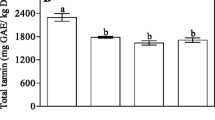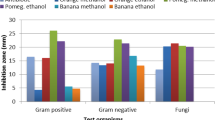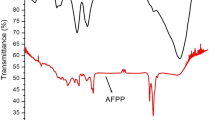Abstract
Pomegranate peels of Ganesh variety were subjected to extraction using different solvents viz. water, methanol and ethanol either alone or in combination with water. The extraction yield, antioxidant activity (DPPH and ABTS inhibition) and total phenolic contents were evaluated. Highest yield was obtained from 50 % ethanol: 50 % water (16.3 ± 1.99 %). The DPPH and ABTS inhibition activity was found to be the highest for methanol and 70 % ethanol: 30 % water extract (79.5 ± 6.5; 94.6 ± 6.10), respectively. The phenolic content was the highest in the aqueous extract (438.3 ± 14.15). The antibacterial activity of peel extracts was tested against four bacterial strains, Staphylococcus aureus, Enterobacter aerogenes, Salmonella typhi and Klebsiella pneumoniae and the extracts demonstrated remarkable antibacterial activities against all the tested bacterial strains. The 70 % ethanol: 30 % water and 100 % water extract had a higher antioxidant activity and phenolic content and has the potential for nutraceutical application.

Similar content being viewed by others
References
Adedapo AA, Jimoh FO, Koduru S, Masika PJ, Afolayan AJ (2008) Evaluation of the medicinal potentials of the methanol extracts of the leaves and stems of Halleria lucida. Bioresource Technol 99:4158–4163
Akowuah GA, Ismail Z, Norhayati I, Sadikun A (2005) The effects of different extraction solvents of varying polarities on polyphenols of Orthosiphon stamineus and evaluation of the free radical-scavenging activity. Food Chem 93:311–317
Al-Zoreky NS (2009) Antimicrobial activity of Pomegranate (Punica granatum L.) fruit peels. Int J Food Microbiol 134:244–248
Amakura Y, Okada M, Tsuji S, Tonogai Y (2000) High performance liquid chromatographic determination with photodiode array detection of ellagic acid in fresh and processed fruits. J Chromat 896:87–93
Artik N (1998) Determination of phenolic compounds in pomegranate juice by using HPLC. Fruit Process 8:492–499
Chang LW, Juang LJ, Wang MY, Tai HM, Hang WJ, Chen YJ, Huang MH (2011) Antioxidant and antityrosinase activity of mulberry (Morus alba L.) twigs and root bark. Food Chem Texicol 49:785–790
Chidambara MKN, Jayaprakasha GK, Singh RP (2002) Studies on antioxidant activity of pomegranate (Punica granatum) peel extract using in vivo models. J Agri Food Chem 50:4791–4795
Cook NC, Samman S (1996) Flavonoids-chemistry metabolism, cardioprotective effects and dietary sources. J Nutr Biochem 7:66–76
Druckerei CH (2002) European Pharmacopoeia, 4th edn. Beck, Nordlingen, p 187
Elfalleh W, Hannachi H, Tlili N, Yahia Y, Nasri N, Ferchichi A (2012) Total phenolic contents and antioxidant activities of pomegranate peel, seed, leaf and flower. J Med Plants Res 6:4724–4730
FAO (2012) Statistical database. Food and Agriculture Organization of the United Nations, Codex Alimentarius Commission: Tunis, Tunesia. http://www.fao.org. (Accessed May 23, 2012)
Ghasemian A, Mehrabian S, Majd A (2006) Peel extracts of two Iranian cultivars of pomegranate (Punica granatum) have antioxidant and antimutagenic activities. Pakistan J Biol Sci 9:1402–1405
Gil MI, Tomas-Barberan FA, Hess-Pierce B, Holcroft DM, Kader AA (2000) Antioxidant activity of pomegranate juice and its relationship with phenolic composition and processing. J Agric Food Chem 48:4581–4589
Hseu YC, Chang WH, Chen CS, Liao JW, Huang CJ, Lu FJ (2008) Antioxidant activities of Toona sinensis leaves extracts using different antioxidant models. Food Chem Toxicol 46:105–114
Jayaprakasha GK, Rao JL (2000) Phenolic constituents from lichen Parmotrema stuppeum (Nyl.) Hale and their antioxidant activity. Z Naturforsch 55:1018–1022
Khan AJ, Hanee S (2011) Antibacterial properties of Punica granatum peels. Int J Applied Biol Pharmaceutical Technol 2:23–27
Kulkarni AP, Aradhya SM (2005) Chemical changes and antioxidant activity in pomegranate arils during fruit development. Food Chem 93:319–324
Lansky EP, Newman RA (2007) Punica granatum (pomegranate) and its potential for prevention and treatment of inflammation and cancer. J Ethnopharmacol 109:177–206
Li Y, Guo C, Yang J, Wei J, Xu J, Cheng S (2006) Evaluation of antioxidant properties of pomegranate peel extract in comparison with pomegranate pulp extract. Food Chem 96:254–260
Melendez PA, Capriles VA (2006) Antibacterial properties of tropical plants from Puerto Rico. Phytomedicine 13:272–276
Mousavinejad G, Emam-Djomeh Z, Rezaei K, Khodaparast MHH (2009) Identification and quantification of phenolic compounds and their effects on antioxidant activity in pomegranate juices of eight Iranian cultivars. Food Chem 115:1274–1278
Nawwar MAM, Hussein SAM, Mefort I (1994) NMR spectral analysis of polyphenols from Punica granatum. Phytochem 36:793–798
Nishino T, Shibahara-Sone H, Kikuchi-Hayakawa H, Lshikawa F (2000) Transit of radical scavenging activity of milk products prepared by Millard reaction and Lactobacillus casei strain shirota fermentation through the Hamster intestine. J Dairy Sci 83:915–922
Plumb GW, De PS, Santos BC (2003) Antioxidant properties of gallaocatechins and prodelphindins from pomegranate peels. Redox Rep 7:41–46
Prashanth D, Asha M, Amit A (2001) Antibacterial activity of Punica granatum. Fitoterapia 72:171–173
Qu WJ, Pan ZL, Zhang RH, Ma HL, Chen XG, Zhu BN, Wang ZB, Atungulu GG (2009) Integrated extraction and anaerobic digestion process for recovery of nutraceuticals and biogas from pomegranate marc. Trans ASABE 52:1997–2006
Qu W, Pan Z, Ma H (2010) Extraction modeling and activities of antioxidants from pomegranate marc. J Food Engg 99:16–23
Re R, Pellegrini N, Proteggente A, Pannala A, Yang M, Rice-Evans C (1999) Antioxidant activity applying an improved ABTS radical cation decolorisation assay. Free Radical Biol Med 26:1231–1237
Satomi H, Umemura K, Ueno A, Hatano T, Okuda T, Noro T (1993) Carbonic anhydrase inhibitors from the pericarps of Punica granatum L. Biol Pharma Bull 16:787–790
Singh RP, Murthy KNC, Jayaprakasha GK (2002) Studies on the antioxidant activity of pomegranate (Punica granatum) peel and seed extract using in vitro models. J Agric Food Chem 50:81–86
Snedecor GW, Cochran WG (1989) Statistical methods, 8th edn. Iowa State University Press, Ames
Soares JR, Dinis TC, Cunha AP, Almeida LM (1997) Antioxidant activity of some extracts of Thymus zygis. Free Radical Res 26:469–478
Supayang PV, Treechada S, Surasak L, Thanomjit S, Tetsuya I, Takeshi H (2005) Inhibitory effects of active compounds from Punica granatum pericarp on verocytotoxin production by enterohemorrhagic Escherichia coli O157:H7. J Health Sci 51:590–596
Tanaka T, Nonaka G, Nishioka I (1986) Tannin and related compounds. XI. Revision of the structure of punicalin and punicalagin, and isolation and characterization of 2-O- galloylpunicalin from the bark of Punica grantum L. Chem Pharma Bull 34:650–655
Tanaka T, Nonaka G, Nishioka I (1990) Tannin and related compounds. C. Reaction of dehydrohexahydroxydiphenic acid esters with bases, and its structure to the application determination of pomegranate tannins, granatins a and b. Chem Pharma Bull 38:9424–9428
Turkmen N, Sari F, Velioglu YS (2006) Effect of extraction solvents on concentration and antioxidant activity of black and black mate polyphenols determined by ferrous tartrate and Folin-Ciocalteu methods. Food Chem 99:838–841
Zhang L, Fu Q, Zhang Y (2011) Composition of anthocyanins in pomegranate flowers and their antioxidant activity. Food Chem 127:1444–1449
Author information
Authors and Affiliations
Corresponding author
Rights and permissions
About this article
Cite this article
Malviya, S., Arvind, Jha, A. et al. Antioxidant and antibacterial potential of pomegranate peel extracts. J Food Sci Technol 51, 4132–4137 (2014). https://doi.org/10.1007/s13197-013-0956-4
Revised:
Accepted:
Published:
Issue Date:
DOI: https://doi.org/10.1007/s13197-013-0956-4




